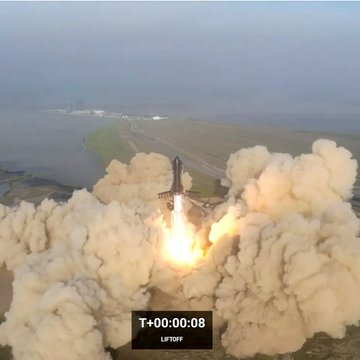Elon Musk’s space exploration company, SpaceX’s massive rocket, Starship, exploded in the air just four minutes after launching in Boca Chica, Texas on Thursday, April 20.
SpaceX’s rocket cleared its launch platform but failed to separate from its booster, exploding four minutes after lift-off during the inaugural flight.
The uncrewed spacecraft, which SpaceX says could one day facilitate multi-planetary life, is worth $3b and is the biggest rocket ever created.
It thundered off the launch pad for what had been expected to be a 90-minute trip around the Earth before a splashdown near Hawaii.
But after reaching MaxQ, the rocket began to spin in the air, then started to plummet before combusting entirely. A livestream of the launch appeared to show some of the 39 engines on the ship had malfunctioned.
“Starship just experienced what we call a rapid, unscheduled disassembly,” said John Insprucker, SpaceX’s principal integration engineer. “As we said, excitement was guaranteed.”
Successfully lifting the 400-foot-tall rocket off the launch pad is still a big step forward to its ultimate goal of one day ferrying humans to the moon and Mars, the company said.
“With a test like this, success comes from what we learn,” the company said in a tweet. “Today’s test will help us improve Starship’s reliability as SpaceX seeks to make life multi-planetary.”
The company says it expected the debris to fall somewhere in the Gulf of Mexico, and it’ll work with local authorities for recovery operations.
A test launch scheduled for Monday was scrapped at the last minute due to a frozen valve in the booster. On Thursday, with 40 seconds left on the countdown clock, the flight crew paused all operations, also due in part to a pressurization issue in the booster.
The decision to use 33 booster engines — more than any other rocket ever made is a trade-off, says Paulo Lozano, director of MIT’s space propulsion laboratory.
Though it’s necessary for lifting payloads of up to 250 tons, “having that large number of rocket engines firing simultaneously — it’s actually quite hard. I think that’s going to be one of the biggest challenges,” Lozano said.
“It was a great find by the countdown team, and that’s why we have a countdown,” said SpaceX quality systems engineer Kate Tice at the time. “We’ve learned a lot over the last 48 hours, and we’re ready to give it another go.”
SpaceX currently uses its Falcon-9 rocket to launch its Starlink Internet satellites into orbit, a few dozen at a time. Starship could one day be able to send several hundred people per launch.
Watch videos below
Elon Musk's SpaceX was able to launch the super-heavy Starship rocket for the second time
However, three minutes after launch and reaching an altitude of 38 km, Starship went into an uncontrolled spin and then exploded. It is reported that the rocket's first stage did not… pic.twitter.com/Ieh7VShE7h
— NEXTA (@nexta_tv) April 20, 2023
Elon Musk’s SpaceX Starship, the world’s biggest rocket and costing $3 billion, exploded four minutes into a planned 90-minute debut flight pic.twitter.com/dqyjdCBdFb
— TRT World (@trtworld) April 20, 2023


